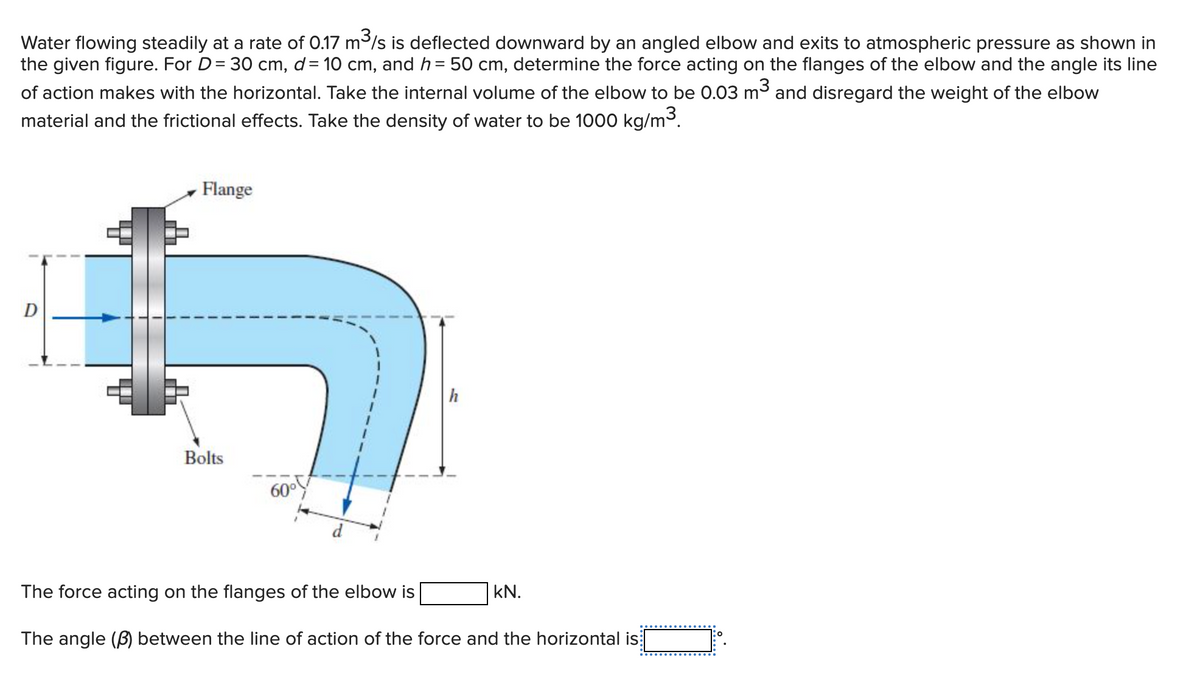Water flowing steadily at a rate of 0.17 m3/s is deflected downward by an angled elbow and exits to atmospheric pressure as shown in the given figure. For D = 30 cm, d = 10 cm, and h = 50 cm, determine the force acting on the flanges of the elbow and the angle its line of action makes with the horizontal. Take the internal volume of the elbow to be 0.03 m3 and disregard the weight of the elbow material and the frictional effects. Take the density of water to be 1000 kg/m3.
Water flowing steadily at a rate of 0.17 m3/s is deflected downward by an angled elbow and exits to atmospheric pressure as shown in the given figure. For D = 30 cm, d = 10 cm, and h = 50 cm, determine the force acting on the flanges of the elbow and the angle its line of action makes with the horizontal. Take the internal volume of the elbow to be 0.03 m3 and disregard the weight of the elbow material and the frictional effects. Take the density of water to be 1000 kg/m3.
Elements Of Electromagnetics
7th Edition
ISBN:9780190698614
Author:Sadiku, Matthew N. O.
Publisher:Sadiku, Matthew N. O.
ChapterMA: Math Assessment
Section: Chapter Questions
Problem 1.1MA
Related questions
Question
Water flowing steadily at a rate of 0.17 m3/s is deflected downward by an angled elbow and exits to atmospheric pressure as shown in the given figure. For D = 30 cm, d = 10 cm, and h = 50 cm, determine the force acting on the flanges of the elbow and the angle its line of action makes with the horizontal. Take the internal volume of the elbow to be 0.03 m3 and disregard the weight of the elbow material and the frictional effects. Take the density of water to be 1000 kg/m3.

Transcribed Image Text:Water flowing steadily at a rate of 0.17 m/s is deflected downward by an angled elbow and exits to atmospheric pressure as shown in
the given figure. For D= 30 cm, d= 10 cm, and h = 50 cm, determine the force acting on the flanges of the elbow and the angle its line
of action makes with the horizontal. Take the internal volume of the elbow to be 0.03 m3 and disregard the weight of the elbow
material and the frictional effects. Take the density of water to be 1000 kg/m3.
Flange
D
h
Bolts
60°
d
The force acting on the flanges of the elbow is
kN.
The angle (B) between the line of action of the force and the horizontal is
Expert Solution
This question has been solved!
Explore an expertly crafted, step-by-step solution for a thorough understanding of key concepts.
This is a popular solution!
Trending now
This is a popular solution!
Step by step
Solved in 5 steps with 1 images

Knowledge Booster
Learn more about
Need a deep-dive on the concept behind this application? Look no further. Learn more about this topic, mechanical-engineering and related others by exploring similar questions and additional content below.Recommended textbooks for you

Elements Of Electromagnetics
Mechanical Engineering
ISBN:
9780190698614
Author:
Sadiku, Matthew N. O.
Publisher:
Oxford University Press

Mechanics of Materials (10th Edition)
Mechanical Engineering
ISBN:
9780134319650
Author:
Russell C. Hibbeler
Publisher:
PEARSON

Thermodynamics: An Engineering Approach
Mechanical Engineering
ISBN:
9781259822674
Author:
Yunus A. Cengel Dr., Michael A. Boles
Publisher:
McGraw-Hill Education

Elements Of Electromagnetics
Mechanical Engineering
ISBN:
9780190698614
Author:
Sadiku, Matthew N. O.
Publisher:
Oxford University Press

Mechanics of Materials (10th Edition)
Mechanical Engineering
ISBN:
9780134319650
Author:
Russell C. Hibbeler
Publisher:
PEARSON

Thermodynamics: An Engineering Approach
Mechanical Engineering
ISBN:
9781259822674
Author:
Yunus A. Cengel Dr., Michael A. Boles
Publisher:
McGraw-Hill Education

Control Systems Engineering
Mechanical Engineering
ISBN:
9781118170519
Author:
Norman S. Nise
Publisher:
WILEY

Mechanics of Materials (MindTap Course List)
Mechanical Engineering
ISBN:
9781337093347
Author:
Barry J. Goodno, James M. Gere
Publisher:
Cengage Learning

Engineering Mechanics: Statics
Mechanical Engineering
ISBN:
9781118807330
Author:
James L. Meriam, L. G. Kraige, J. N. Bolton
Publisher:
WILEY